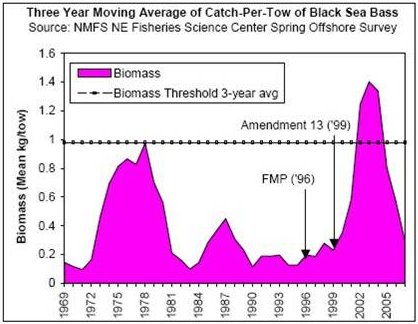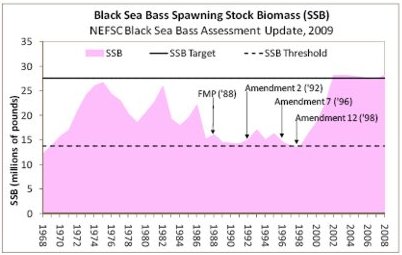  |
 |
|
Here is a summary of the problem with black sea bass management and why this closure has come about. A lengthy description follows, but here it is in a nut shell. Sea bass are an incredibly healthy stock, they are not overfished and overfishing is not occurring. A "perfect storm" has occurred of -
And that is why we are where we are now. All the problems we've known for years have finally come to a disastrous head. Read on for the full picture. Black sea bass are known as a "data poor stock", simply meaning there is significantly less known about the stock and the species than a species like summer flounder. In previous years, fisheries scientists did not have enough data to put together a stock assessment to determine how the stock was fairing. Since they were mandated by Magnuson to do something, management had been using the 3-year average abundance in their trawl surveys. We all know sea bass typically congregate around structure, areas you try to avoid with a trawl. Nonetheless, this was how management worked, and, not surprisingly, the catch often wasn't much. When they had a good year catching fish as they migrated, it skewed the results. (The best year ever they managed a "whopping" 1.4 kg/tow, or just over 3 pounds!) Here is what that looked like -  Since those "great" tows of earlier this decade, the abundance has been much closer to the norm, as you can see, but since this was below their proxy, the stock was considered "overfished", and Magnuson mandated it be rebuilt by 2010. Therefore, for the 2009 season, it was determined that the sea bass quota would be cut in half (and we got the resulting 12.5" size limit this year). During this time, more information was being gathered, enough so that in the past year a full stock assessment model could be generated about black sea bass. So, this spring, the announcement was made that the stock is not overfished and no overfishing was occurring. In fact, their assessment showed a stable stock AT OR ABOVE THEIR TARGETS throughout the entire past decade -  As a result of this current "best available science", the Monitoring Committee (which has been working on this for many years) came to the conclusion that the 2010 quota should be restored to the level it was at in 2008 (which was the approx. average annual landings of the past decade). Hey, fisheries management is working! But wait... Another committee, the Science and Statistical Committee (which does not have any history managing the fishery), said that since the stock assessment was new, caution should prevail and "status quo" should be maintained. What they failed to discuss, however, was that "status quo" was the average landings of the decade (the quota in 2008), as opposed to the unnecessarily halved quota of 2009. If the new assessment had been out a few months earlier, the quota for 2009 would never have been halved as it was. But this wasn't fully discussed, so the SSC made a recommendation for the 2010 quota to be set to the same level as 2009. The Mid-Atlantic Fisheries Management Council (MAFMC) met in August to vote on the 2010 quota. The MAFMC's hands were tied, as the inflexibility in Magnuson bound the Council to set a quota that did not exceed the upper bounds of the recommendation by the SSC. Upon discussing the fact that the SSC did not discuss and fully understand the recent management history of sea bass, a motion was made by the Council to ask the SSC to reconvene and discuss the information and history available to the Monitoring Committee. The motion looked like it was going to pass by a vote of 10-9, but then the MAFMC Chairman decided to cast his vote against the motion. Thus, the vote ended in a tie of 10-10, the motion to have the SSC reconvene failed, and left with no other choice, the 2010 quota was set at the same level as 2009, approx. 2.3 million pounds. The way things happened was extremely unfortunate. Based on the way things happened, the MAFMC realized there was a problem with the process, so much so that they have an entire day of their next meeting in October set aside to discuss specifically the interactions of the SSC, the MC and the MAFMC. If that isn't acknowledging a problem, I don't know what is. From a recreational fishermen's perspective, it was going to mean another year at 12.5", but it could have been worse. And then it did get worse. By the third week of August, we learned that preliminary numbers from the "fatally flawed" MRFSS system (that is supposed to be used to estimate recreational landings but is instead being used as an absolute number to hold recreational fishermen's feet to the fire on landings) said that according to the first half of the year's landings, black sea bass landings could exceed the 2009 quota by well over 100%. Keep in mind that this is the same data that says that in May and June this year, VA saw a 982% increase in pounds of black sea bass landed (81,018 total fish) as compared to 2008 while neighboring MD landed 706 TOTAL FISH during those 2 months. Someone build a wall in the ocean between the two states? As a result of this "overage", states met on Sept. 1st to discuss closing the fishery in state waters, but in looking at all of the above voted not to do so. (At the meeting, NOAA Fisheries and the US Fish and Wildlife Service both voted in favor of the state shutdown.) We were threatened with this closure on the federal side at that time since the states didn't take action, and here it is. A 180 day closure of the EEZ to recreational angling for black sea bass effective on October 5th, 2009. So there you have it, like the "perfect storm" of October 1991 that drastically affected the Mid-Atlantic and New England coasts, here we have the "perfect storm" of fisheries of 2009 that will again drastically affect the Mid-Atlantic and New England coasts. 3 storms - deadly enough on their own, absolutely disastrous when combined - have come together. A broken process (the SSC, MC and MAFMC interactions), inflexibility in Magnuson (no choice for the MAFMC but to rubber stamp what the SSC recommends), and the "fatally flawed" MRFSS system being used for absolute landings, for which it was never intended and absolutely should not be used. |
|
Home | About The Vessel | About The Captain | Policies & Rates | Fishing Report Image Gallery | Species Guide | How-To Articles | Color Brochure | Contact Info & Directions Join E-Mail List | Issues in Fisheries Management | Affiliations / Links ©Copyright 2003 - 2024 Karen Ann Charters LLC - All Rights Reserved |
|
||||